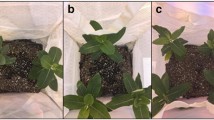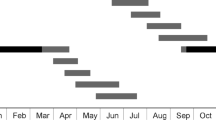Abstract
Larvae of the eastern tent caterpillar, Malacosoma americanum, undergo density-dependent dispersal in response to depleted resources. Because these caterpillars have recently been implicated in abortions of pregnant mares (equine Mare Reproductive Loss Syndrome, or MRLS), there is increased interest in managing caterpillar populations, potentially through manipulation of caterpillar dispersal behavior. Consequently, we investigated dispersal patterns of food-deprived eastern tent caterpillars in artificial arenas with respect to distance, direction, and response to visual stimuli. Distance traveled is influenced by time of day, and is strongly correlated with time elapsed. Movement is non-random, and correlates closely with the position of the sun. The pattern is more pronounced with foraging third instars than with penultimate fifth instars. Visual cues appear important in caterpillar orientation, and caterpillars are responsive to vertically oriented, black objects.
Similar content being viewed by others
References
Barbosa, P., Krischik, V., and Lance, D. (1989). Life history traits of forest-inhabiting flightless Lepidoptera. Am. Midl. Nat. 122: 262–274.
Batschelet, E. (1981). Circular Statistics in Biology, Academic Press, New York.
Chapman, R. F. (1998). The Insects: Structure and Function, 4th ed, Cambridge University Press, Cambridge.
Crump, D., Silverstein, R. M., Williams, H. J., and Fitzgerald, T. D. (1987). Identification of trail pheromone of larva of eastern tent caterpillar, Malacosoma americanum (Lepidoptera: Lasiocampidae). J. Chem. Ecol. 13: 397–402.
Dethier, V. G. (1942). The dioptric apparatus of lateral ocelli. I. The corneal lens. J. Cell. Comp. Physiol. 19: 301–313.
Dethier, V. G. (1943). The dioptric apparatus of lateral ocelli. II. Visual capacities of the ocellus. J. Cell. Comp. Physiol. 22: 115–126.
Dethier, V. G. (1980). The World of the Tent-Makers: A Natural History of the Eastern Tent Caterpillar, University of Massachusetts Press, Amherst.
Dingle, H. (1972). Migration strategies of insets. Science 15: 1327–1335.
Doane, C. C., and McManus, M. L. (1981). The gypsy moth: Research toward integrated pest management. USDA For. Serv. Tech. Bull. 1584. Washington, DC.
Drooz, A. T. (1985). Insects of eastern forests. USDA For. Serv. Misc. Publ. 1426. Washington, DC.
Edgerly, J. S., and Fitzgerald, T. D. (1982). An investigation of behavioral variability within colonies of the eastern tent caterpillar Malacosoma americanum (Lepidoptera: Lasiocampidae). J. Kansas Entomol. Soc. 55: 145–155.
Fitzgerald, T. D. (1993). Trail following and recruitment: Response of eastern tent caterpillar, Malacosoma americanum, to 5β-cholestane-3,24-dione and 5β-cholestane-3-one. J. Chem. Ecol. 19: 449–457.
Fitzgerald, T. D., (1995). The Tent Caterpillars, Comstock Publishing, Ithaca, New York.
Fitzgerald, T. D., Casey, T., and Joos, B. (1988). Daily foraging schedule of field colonies of the eastern tent caterpillar, Malacosoma americanum. Oecologia 76: 547–578.
Fitzgerald, T. D., and Peterson, S. C. (1983). Elective recruitment communication by the eastern tent caterpillar (Malacosoma americanum). Anim. Behav. 31: 417–423.
Fitzgerald, T. D., and Willer, D. E. (1983). Tent-building behavior of the eastern tent caterpillar, Malacosoma americanum (Lepidoptera: Lasiocampidae). J. Kans. Entomol. Soc. 56: 20–31.
Horn, D. J. (1988). Ecological Approach to Pest Management, Guilford Press, New York.
Hundertmark, A. (1937). Das Formunterscheidungsvermogen der Eiraupen der Nonne (Lymantria monacha). Z. Verg. Physiol. 24: 563–582.
Joos, B. (1992). Adaptations for locomotion at low body temperatures in eastern tent caterpillars, Malacosoma americanum. Physiol. Zool. 65: 1148–1161.
Kane, E., and Kirby, E. (2001). Death in the bluegrass. Equus 287: 60–68.
McDowell, K., and Webb, B. (2003). Deductive Investigation of the Causes of Mare Reproductive Loss Syndrome: Experiment 4. http://www.uky.edu/Agriculture/VetScience/mrls/Deductive%20Investigation060603.html.
Morris, R. F., (ed.) (1963). The dynamics of epidemic spruce budworm populations. Mem. Entomol. Soc. Can. 31: 1–332.
Rainey, R. C., (ed.) (1976). Insect Flight. Symp. R. Entmol. Soc. London 7, Royal Entomological Society of London.
Rieske, L. K. (2004). Age-specific host utilization in the eastern tent caterpillar, Malacosoma americanum Fabricius (Lepidoptera: Lasiocampidae). J. Entomol. Sci. 39: 94-100.
Roden, D. B., Miller, J. R., and Simmons, G. A. (1992). Visual stimuli influencing orientation by the larval gypsy moth, Lymantria dispar (L.). Can. Entomol. 124: 287–304.
Roessingh, P., Peterson, S. C., and Fitzgerald, T. D. (1988). The sensory basis of trail following in some lepidopterous larvae: Contact chemoreception. Physiol. Entomol. 13: 219–224.
SAS Institute. (1997). SAS/STAT Software: Changes and Enhancements Through Release 6.12, Cary, North Carolina.
Stehr, F. W., and Cook, E. F. (1968). A revision of the genus Malacosoma Hubner in North America (Lepidoptera: Lasiocampidae): Systematics, biology, immatures, and parasites. US Natl. Mus. Bull. 276. Washington, DC.
Tietz, H. M. (1972). Index to the Described Life Histories, Early Stages and Hosts of the Macrolepidoptera of the Continental United States and Canada, Vol. 1, Allyn Museum of Entomology, Sarasota, Florida.
Townsend, L. H. (2002a). Control of Eastern Tent Caterpillars, http://www.uky.edu/Agriculture/VetScience/mrls/ETC502.html.
Townsend, L. H. (2002b). Farm Contingency Plan for MRLS Risk Reduction for Kentucky Horse Farms; Eastern Tent Caterpillar Recommendations – 2002, http://www.uky.edu/Agriculture/Entomology/bugalert/bugalert15.htm.
UK Ag. Weather Data (2002). University of Kentucky Agricultural Weather. http://wwwagwx.ca.uky.edu/.
U.S. Naval Observatory. (2003). Astronomical Applications. http://aa.usno.navy.mil/data/docs/.
Wellington, W. G., Sullivan, C. R., and Green, G. W. (1951). Polarized light and body temperature level as orientation factors in the light reactions of some hymenopterous and lepidopterous larvae. Can. J. Zool. 29: 339–351.
Wellington, W. G., Cameron, P. J., Thompson, W. A., Vertinsky, I. E., and Landsberg, A. S. (1975). A stochastic model for assessing the effects of external and internal heterogeneity of an insect population. Res. Popul. Ecol. 17: 1–28.
Author information
Authors and Affiliations
Corresponding author
Rights and permissions
About this article
Cite this article
Rieske, L.K., Townsend, L.H. Orientation and Dispersal Patterns of the Eastern Tent Caterpillar, Malacosoma americanum F. (Lepidoptera: Lasiocampidae). J Insect Behav 18, 193–207 (2005). https://doi.org/10.1007/s10905-005-0475-x
Received:
Revised:
Issue Date:
DOI: https://doi.org/10.1007/s10905-005-0475-x




